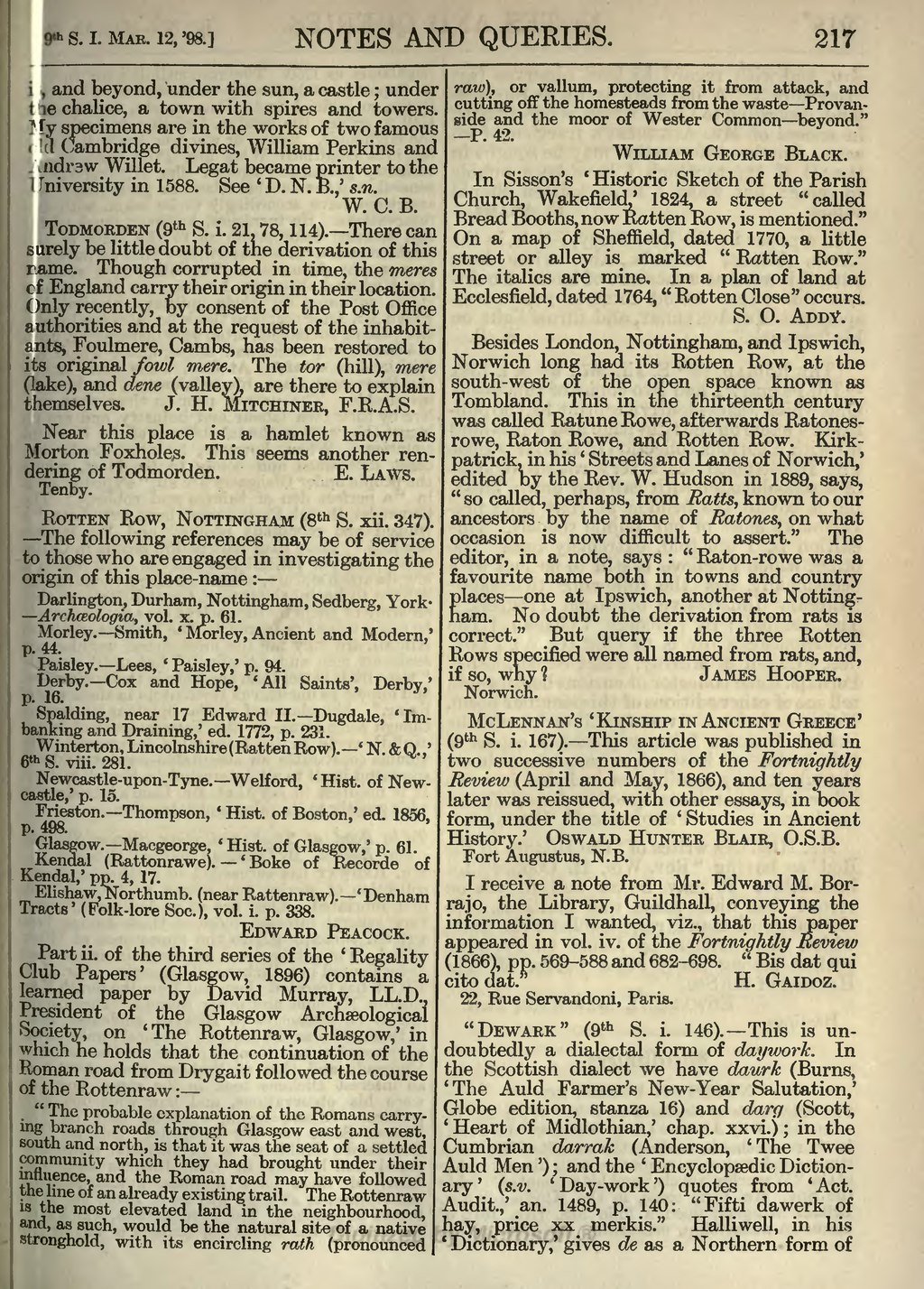9 th S. I. MAR. 12, '98.]
NOTES AND QUERIES.
217
, and beyond, under the sun, a castle ; unde:
t le chalice, a town with spires and towers
Hy specimens are in the works of two famous
kl Cambridge divines, William Perkins anc
j. Jidrsw Willet. Legat became printer to th
University in 1588. See ' D. N. B.,' s.n.
W. C. B.
TODMORDEN (9 th S. i. 21, 78, 114). There can surely be little doubt of the derivation of this name. Though corrupted in time, the mere. cf England carry their origin in their location Only recently, by consent of the Post Office authorities and at the request of the inhabit ants, Foulmere, Cambs, has been restored to its original fowl mere. The tor (hill), mere (lake), and dene (valley), are there to explain themselves. J. H. MITCHINER, F.R.A.S.
Near this place is a hamlet known as Morton Foxholes. This seems another ren- dering of Todmorden. E. LAWS.
Tenby.
ROTTEN Row, NOTTINGHAM (8 th S. xii. 347). The following references may be of service to those who are engaged in investigating the origin of this place-name :
Darlington, Durham, Nottingham, Sedberg, York -Archceologia, vol. x. p. 61.
Morley. Smith, ' Morley, Ancient and Modern,' p. 44.
Paisley. Lees, Paisley,' p. 94.
Derby. Cox and Hope, 'All Saints', Derby,' p. 16.
Spalding, near 17 Edward II. Dugdale, Tm- banking and Draining,' ed. 1772, p. 231.
Winterton, Lincolnshire (Ratten Row).' N. & Q. ' 6 th S. viii. 281.
Newcastle-upon-Tyne. Welford, 'Hist, of New- castle,' p. 15.
Frieston. Thompson, ' Hist, of Boston,' ed. 1856, p. 498.
Glasgow. Macgeorge, 'Hist, of Glasgow,' p. 61.
Kendal (Rattonrawe). ' Boke of Recorde of Kendal,' pp. 4, 17.
Elishaw, Northumb. (near Rattenraw). ' Denham Tracts' (Folk-lore Soc.), vol. i. p. 338.
EDWARD PEACOCK.
Part ii. of the third series of the * Regality Club Papers' (Glasgow, 1896) contains a learned paper by David Murray, LL.D., President of the Glasgow Archaeological Society, on 'The Rottenraw, Glasgow,' in which he holds that the continuation of the Roman road from Drygait followed the course of the Rottenraw :
' The probable explanation of the Romans carry- ing branch roads through Glasgow east and west, south and north, is that it was the seat of a settled community which they had brought under their nttuenee, and the Roman road may have followed the line of an already existing trail. The Rottenraw
the most elevated land in the neighbourhood, tnd, as such, would be the natural site of a native tronghold, with its encircling rath (pronounced
raw), or vallum, protecting it from attack, and
cutting off the homesteads from the waste Provan-
side and the moor of Wester Common beyond."
-P. 42.
WILLIAM GEORGE BLACK. In Sisson's ' Historic Sketch of the Parish Church, Wakefield,' 1824, a street "called Bread Booths, now Ratten Row, is mentioned." On a map of Sheffield, dated 1770, a little street or alley is marked " Ratten Row." The italics are mine. In a plan of land at Ecclesfield, dated 1764, " Rotten Close" occurs.
S. O. ADD*.
Besides London, Nottingham, and Ipswich, Norwich long had its Rotten Row, at the south-west of the open space known as Tombland. This in the thirteenth century was called Ratune Rowe, afterwards Ratones- rowe, Raton Rowe, and Rotten Row. Kirk- patrick, in his ' Streets and Lanes of Norwich,' edited by the Rev. W. Hudson in 1889, says, " so called, perhaps, from Ratts, known to our ancestors by the name of ftatones, on what occasion is now difficult to assert." The editor, in a note, says : "Raton-rowe was a favourite name both in towns and country places one at Ipswich, another at Nottingr ham. No doubt the derivation from rats is correct." But query if the three Rotten Rows specified were all named from rats, and, if so, why ? JAMES HOOPER.
Norwich.
MCLENNAN'S 'KINSHIP IN ANCIENT GREECE' (9 th S. i. 167). This article was published in two successive numbers of the Fortnightly Review (April and May, 1866), and ten years later was reissued, with other essays, in book form, under the title of ' Studies in Ancient History.' OSWALD HUNTER BLAIR, O.S.B.
Fort Augustus, N.B.
I receive a note from Mr. Edward M. Bor- rajo, the Library, Guildhall, conveying the information I wanted, viz., that this paper appeared in vol. iv. of the Fortnightly Meview 1866), pp. 569-588 and 682-698. " Bis dat qui citodat." H. GAIDOZ.
22, Rue Servandoni, Paris.
"DEWARK" (9 fch S. i. 146). This is un- doubtedly a dialectal form of daywork. In
- he Scottish dialect we have daurk (Burns,
The Auld Farmer's New- Year Salutation,' jlobe edition, stanza 16) and darg (Scott, Heart of Midlothian,' chap, xxvi.) ; in the Cumbrian darrak (Anderson, ' The Twee Auld Men ') ; and the ' Encyclopaedic Diction- ary' (s.v. 'Day-work') quotes from 'Act. Audit.,' an. 1489, p. 140: "Fifti dawerk of lay, price xx merkis." Halliwell, in his Dictionary,' gives de as a Northern form of
